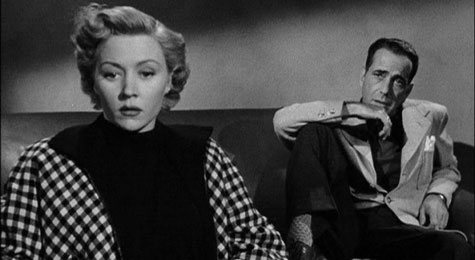
I am approaching this post on In a Lonely Place as a page-to-screen piece, where I’ll compare notes on the novel of that title and the movie that goes by the same name. But really, there’s little in common between Dorothy B. Hughes’s 1947 book and the 1950 film directed by Nicholas Ray. Let’s talk about the couple of things that make the two alike first, and then we’ll turn to the differences.
In both the page and screen version, the primary character is a man named Dixon “Dix” Steele. Dix is a military vet living in post-war Los Angeles, he’s known to have volatile, physically aggressive episodes, and he is under suspicion of having committed murder. Also, one of the police detectives investigating him is a man named Brub Nicolai—a former war buddy of Dix’s who is now a cop. Finally, in both versions, Dix falls in love with a woman named Laurel Gray, who goes for him, but has to wonder if she might be getting involved with a murderer.
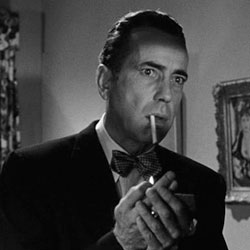 The differences between the book and movie are plentiful. In the movie, Dix—who is portrayed by Humphrey Bogart, in a role that some Bogie nuts see as one of his finest performances—is suspected of only one murder. He is a screenwriter whose drive for artistic integrity in the face of a commercially crass movie business puts him at odds with many of the people in his field of work. He has a good-natured, if flighty, woman come to his apartment one night to help him with a scriptwriting job he doesn’t really want to do. And, when that woman is strangled to death in the wee hours, Dix is under suspicion because:
The differences between the book and movie are plentiful. In the movie, Dix—who is portrayed by Humphrey Bogart, in a role that some Bogie nuts see as one of his finest performances—is suspected of only one murder. He is a screenwriter whose drive for artistic integrity in the face of a commercially crass movie business puts him at odds with many of the people in his field of work. He has a good-natured, if flighty, woman come to his apartment one night to help him with a scriptwriting job he doesn’t really want to do. And, when that woman is strangled to death in the wee hours, Dix is under suspicion because:
- He is the last known person to have been with the woman.
- He has a long police record of incidents that involve him physically attacking other people, including women.
As the investigation of the killing commences, Dix meets and falls for Laurel.
In the book, however, there are numerous murders that Dix may be responsible for, including that of a woman he fell in love with while overseas during the war. Another difference between novel and movie is that, in Hughes’s version, Dix is only a wannabe writer—one who tells an uncle of his that he is going to author a novel, which is a lie told to secure the patronage of, and a livable allowance from, the uncle. The book version of Dix never writes a word.
Bogart’s Dix is a man who will work hard at his screenwriting, at least when he has an assignment that he believes in. And, something more broad that distinguishes Hughes’s Dix from Ray’s/Bogart’s is that, in the movie, he is a conflicted man who is capable of showing likeable qualities, even though his volatility makes him unreliable and dangerous at times. In the book, he is simply a hotheaded, violent creep, whom Hughes never tries to make sympathetic.
Another major distinction between the novel and the film is what creates the primary conflicts and tension in each. In both versions, it’s a highly charged story in terms of suspense, danger, romantic involvement, and challenged friendship. But, the way the tautness is brought out is very different between the page and screen takes of the tale.
While the complicated relationship between Dix and Laurel is a source of tension in both book and film, in Hughes’s novel, the cat and mouse game played between Dix, whom we know is a murderer from the start of the story, and the police—particularly the interplay between Dix and his friend who is investigating him, even while they socialize—provides another important factor.
By contrast, in the cinematic edition, much of the suspense is brought on by Dix’s efforts to handle the strain of having the police suspect him of murder. This problem is delivered to its breaking point when he comes to understand that they have gotten Laurel—whom he loves—to work with them on the case against him, behind his back. Also, the inner struggles Laurel has to contend with, as she experiences both feelings for Dix and the question of whether he might really be a killer, are especially well captured in the movie version.
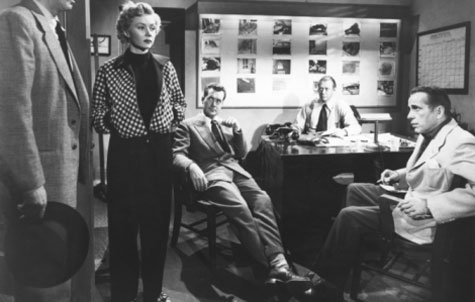
For the record, while I think the basic premise of Hughes’s novel was an inspired idea, I feel that the book falls short of its promise. Hughes spent far too much time telling the reader what Dix and Laurel are thinking and feeling, versus just showing us. Her narrator’s observations become oppressive over time. And, if that makes it sound like I’m generally down on Dorothy B. Hughes’s writing, that’s not the case at all, as her 1946 title Ride the Pink Horse is a personal favorite of mine, among works of noir fiction.
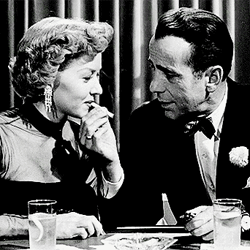 Much of what drives the movie version of In a Lonely Place, besides Ray’s keen directorial sensibilities, is the chemistry between Bogart and Gloria Grahame, who plays Laurel. They are electric together, from their first shared scene to the film’s climax. And, their verbal exchanges, some of which were penned by scriptwriter Andrew Solt and some of which were improvised on the spot, are sharp throughout, whether they take the form of witty repartee or emotionally weighty words.
Much of what drives the movie version of In a Lonely Place, besides Ray’s keen directorial sensibilities, is the chemistry between Bogart and Gloria Grahame, who plays Laurel. They are electric together, from their first shared scene to the film’s climax. And, their verbal exchanges, some of which were penned by scriptwriter Andrew Solt and some of which were improvised on the spot, are sharp throughout, whether they take the form of witty repartee or emotionally weighty words.
There are intriguing back-story elements to the film In a Lonely Place. Louise Brooks, who seems to have known Bogart well, wrote that the personality of the hardened but vulnerable, mercurial, and isolated Dix Steele was the closest of Bogart’s on-screen characters to his own. Then, there’s the fact that Ray and Grahame were wedded at the time of the film’s making, and that their marriage was coming apart. Ray had an apartment put together for himself on the set, and that’s where he lived through the making of the film—a separation arrangement that he and Grahame kept private at the time.
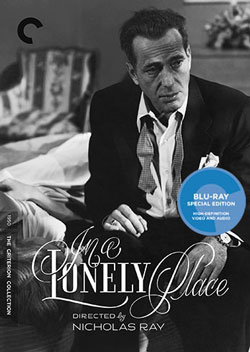 There is a new Criterion Blu-Ray/DVD edition of In a Lonely Place that was released in May, and in one of the bonus features detailed in the next paragraph, a biographer of Grahame says that the film version of Dix Steele was in many ways a reflection of Ray, and in particular of Ray’s ways in being Grahame’s husband. So, as we watch Dix Steele up on the screen, we can think of him as being like both Bogart and Ray in their actual lives: quite a mix of personalities.
There is a new Criterion Blu-Ray/DVD edition of In a Lonely Place that was released in May, and in one of the bonus features detailed in the next paragraph, a biographer of Grahame says that the film version of Dix Steele was in many ways a reflection of Ray, and in particular of Ray’s ways in being Grahame’s husband. So, as we watch Dix Steele up on the screen, we can think of him as being like both Bogart and Ray in their actual lives: quite a mix of personalities.
Of course, any time you’re talking about a Criterion edition of a movie, you have to consider the extras included—and the bonus features of their new version of In a Lonely Place are exceptional.
There is a 45-minute documentary on Ray, from 1975, called I’m a Stranger Here Myself. The short biopic focuses on a project Ray was working on around that time, when he got hired by Harpur College to come to the school and lead a group of film students through a movie-making project.
That footage is quite interesting, and other big pluses in the documentary include interview snippets with: John Houseman, who was a friend of Ray’s and who sheds light on Ray’s experiences in filmmaking; Francois Truffaut, who tells of the great influence Ray had on his own movie directing; and Natalie Wood, who gives the story of how she got her part in the Ray-directed Rebel Without a Cause.
Also in the documentary, Ray gives some illuminating information about In a Lonely Place, including how he changed the ending from the script version and why he made the changes. The extras also include the aforementioned new interview with Gloria Grahame biographer Vincent Curio, in which he offers insights into Grahame’s experiences in making In a Lonely Place, among other details about her life and her marriage to Ray.
There’s also a bonus segment in which filmmaker Curtis Hanson gives his thoughts on In a Lonely Place, as well as a 1948 radio adaptation of Hughes’s novel and an audio commentary track from film scholar Dana Polan. The booklet to the Blu-Ray/DVD edition comes with an essay by Imogen Sara Smith, who has authored several books on the history of cinema.
There are many reasons why the movie In a Lonely Place is both an enduring classic of film noir and one with an intriguing back-story. It perfectly captures some compelling human conflicts: a troubled person fighting powerful internal demons and a person who loves somebody whom she also fears. And, it lets us see inside the unsettled personalities of two of the cinema’s most accomplished artists.
This new Criterion edition gives people who have never seen the film a great excuse to become introduced. And, for those of us who already knew it, it is a means through which to come to appreciate it on a deeper level.
Brian Greene writes short stories, personal essays, and reviews and articles of/on books, music, and film. His work has appeared in 25+ publications since 2008. His pieces on crime fiction have also been published by Noir Originals, Crime Time, Paperback Parade, The Life Sentence, Stark House Press, and Mulholland Books. Brian lives in Durham, North Carolina. His writing blog can be found at: http://briangreenewriter.blogspot.com/

This is such an amazing film that with each viewing I come to respect some new element of Bogart’s performance (I’m a nut), the direction, plot, etc. Must see the new Criterion Blu-Ray/DVD edition at some point! Thanks, Brian. Interesting to note diferences between book and film and it seems I’d be disappointed in the printed page for a change. Thankfully Hughes wrote it though.
Thanks, David. I feel the same way about the film. I think you’ll appreciate the extras in the Criterion edition, particularly the documentary on Ray.
Backstreet Boys BSB are an American boy band. The band was founded on April 20, 1993 in Orlando, Florida, by Lou Pearlman. Now this is the most successful boy band with more than 100 million records sold all around the world. The band was named after a flea market in Orlando, the “backstreet flea market”. In 2019 BB has more than 50 concerts in the US with their DNA tour. Check them at Backstreet Boys concerts site. Full list of tour dates & concerts!
New Kids on the Block is my favourite band of 90s. NKOTB had so many hit songs! The ones I remember are ‘Tonight’, ‘Baby, I Believe In You’ and, of course their hit ‘Step By Step’. These are real songs, not garbage like today! And it is sooo good NKOTB have a tour in 2019! So I’m going to attend New Kids on the Block concert this year. The full list is here: New Kids on the Block tour Sunrise. Check it out and maybe we can even visit one of the concerts together!
Carrie Underwood is my favourite country singer. She is young, beautiful and charming woman in her 30s. Her strong voice takes me away from all troubles of this world so I can enjoy my life and listen songs created by her mind. Now the singer is on a Cry Pretty 360 Tour started in May of 2019. The concerts scheduled for the whole 2019, up to the last day of October. Ticket prices are moderate and available for all men and women with different income. If you are a country music lover as me, then you must visit at least one Carrie’s concert. All tour dates are available at the Carrie Underwood tour Oklahoma City. Visit the website and make yourself familiar with all Carrie Underwood concerts in 2019!
I like rock bands! I really do! And my favourite hard rock band is Hootie & Blowfish! All band members has reunited to perform more than 50 concerts to their fans in 2019! To know more about Hootie&Blowfish in 2019 visit website Hootie and the Blowfish concert list. You won’t miss any concert this year if you click on the link!